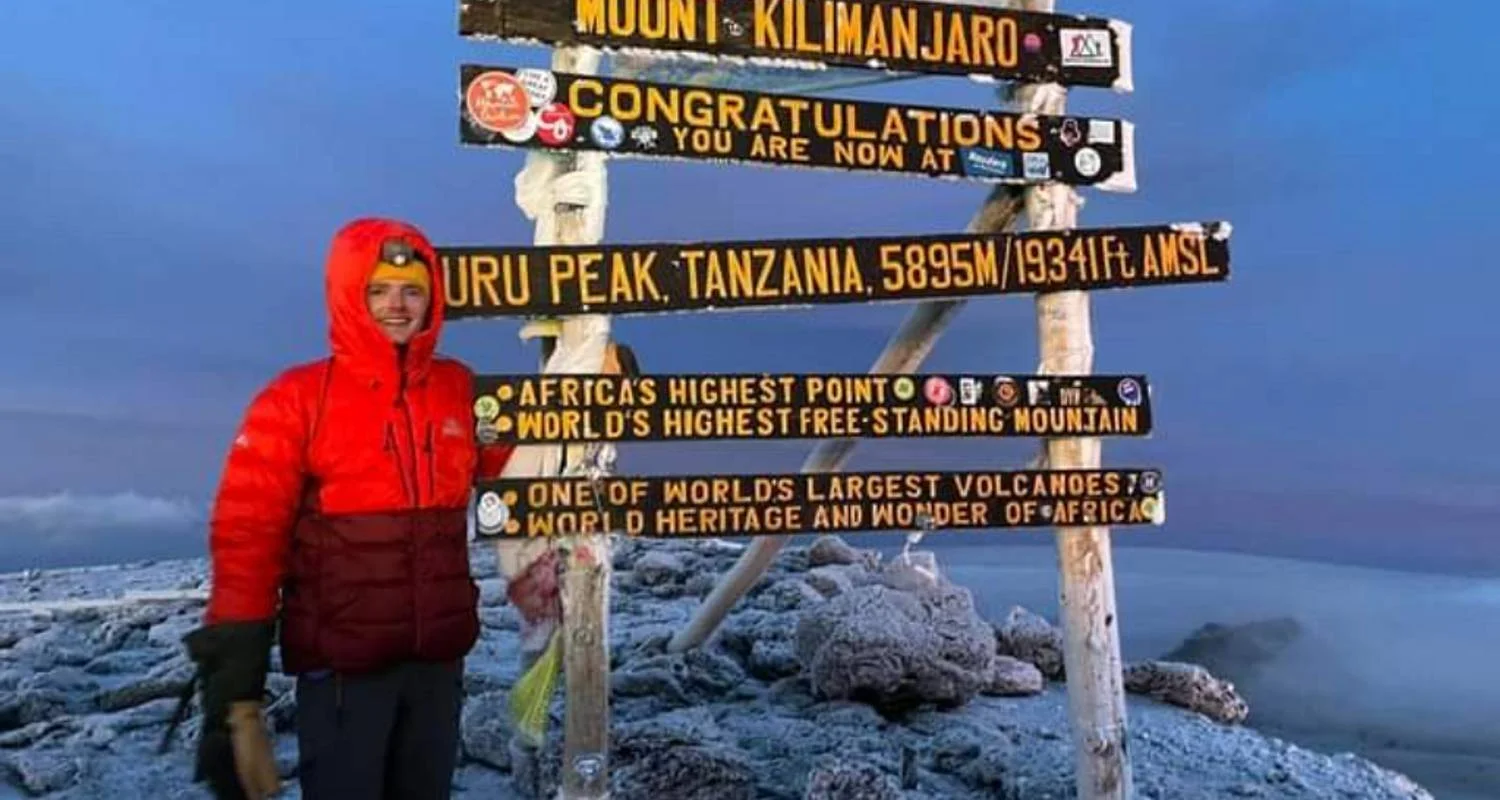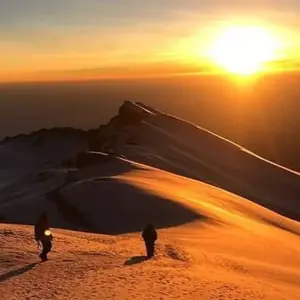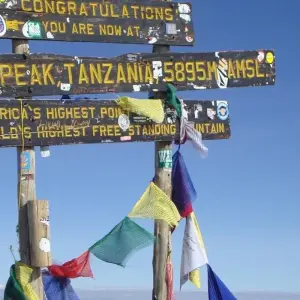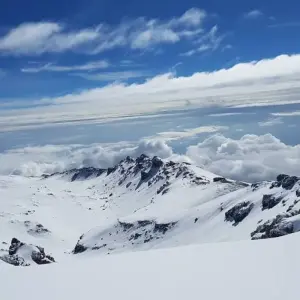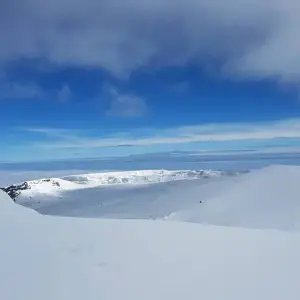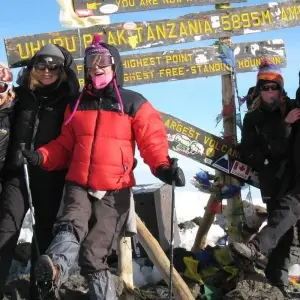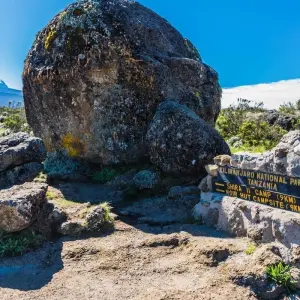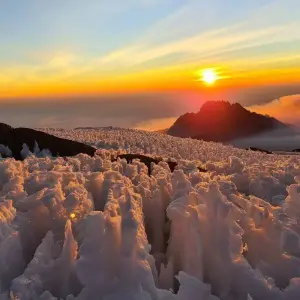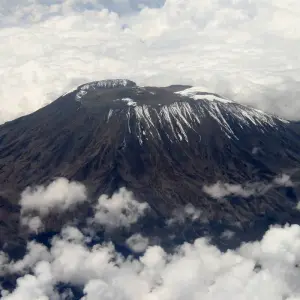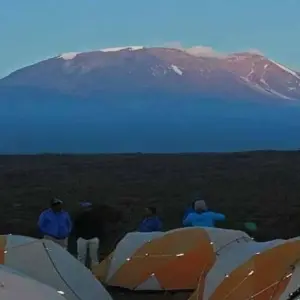Arrive anytime at Kilimanjaro International Airport (JRO). We will arrange a private transfer from Kilimanjaro International Airport (JRO) to your Hotel and Hotel is included, We will gather in the hotel for a pre-climb briefing and an equipment check. We will also confirm you have the appropriate mandatory medical coverage and travel insurance. The Kilimanjaro trekking begins and end at moshi.
Itinéraire
La route de Rongai est la route du Kilimandjaro qui commence par le côté nord, une route où l'on voit peu d'alpinistes. Cette route permet de voir de près le volcan Mawenzi (le deuxième plus haut sommet du Kilimandjaro) et la magnifique selle entre le Mawenzi et le pic Kibo. Cependant, il faut faire un long trajet en voiture jusqu'au parc, car il faut passer par la porte de Marangu pour obtenir un permis.
L'itinéraire est relativement solitaire, car vous traversez une nature sauvage et préservée, avec peu de foules pour vous déranger. Votre trek commence près de la frontière du Kenya, et vous atteindrez le sommet par la route de Marangu et le point de Gilimans. La descente se fera par la route de Marangu. Nous proposons deux options pour la route de Rongai, soit des treks de 5/6/7 jours, le trek de 7 jours étant fortement recommandé pour l'acclimatation.
Programme du circuit
Arrivée à l'aéroport international du Kilimandjaro
Point de départ
Kilimanjaro, Tanzania
07:00 - 17:00
Moshi/Marangu à Rongai Gate (Nalemoru) à Simba Camp
Drive to the attractive wooden village of Nalemoru (about 4 hours including a stop to get permits at Marangu). After signing in and preparing the porters, you will begin the hike on a wide path that winds through fields of maize and potatoes before entering pine forest. The track then starts to climb consistently but gently through attractive forest that shelters a variety of wildlife. The forest begins to thin out and the first camp is at the edge of the moorland zone with extensive views over the Kenyan plains.
Du camp Simba à la deuxième grotte
Elevation: 2650m to 3450m, Distance: 6km, Walking Time: 3-4 hours, Habitat: Moorland
The morning hike is a steady ascent up to the Second Cave with superb views of Kibo and the eastern ice fields on the crater rim
Deuxième grotte au camp Kikelewa
Elevation: 3450m to 3600m, Distance: 9km, Walking Time: 2-3 hours, Habitat: Semi-desert,
Head out across the moorland on a smaller path towards the jagged peaks of Mawenzi. The campsite is in a sheltered valley with giant Senecios nearby.
De Kikelewa Camp à Mawenzi Turn Hut
Elevation: 3600m to 4330m, Distance: 6km, Walking Time: 3-4 hours, Habitat: Semi-desert
A short but steep climb up grassy slopes is rewarded by superb views. Leave the vegetation behind shortly before reaching the next camp at Mawenzi Turn, spectacularly situated in a cirque directly beneath the towering spires of Mawenzi. The afternoon will be free to rest or explore the surrounding area as an aid to acclimatization.
If you are spending an extra day on the mountain, you will camp for two nights here. You can hike up and around Mawenzi for your acclimatization hike.
De Mawenzi Turn hut à Kibo Hut
Elevation: 4330m to 4750m, Distance: 9km, Hiking Time: 4-5 hours, Habitat: Alpine Desert
Cross the lunar desert of the ‘Saddle’ between Mawenzi and Kibo to reach Kibo campsite at the bottom of the Kibo crater wall. The remainder of the day is spent resting in preparation for the final ascent very early.
Kibo Camp to Summit et Horombo Hut
Elevation: 4700m to 5895m & down to 3700m, Distance: 6km up & 15km down, Hiking Time: 6-8 hours up & 15km down, Habitat: Alpine Desert
Very early in the morning (midnight about 2am), commence the climb to the summit on steep and heavy scree or snow up to Gilman’s Point located on the crater rim (elevation 5700m). Continuing ascend to Uhuru Peak, which is the highest point in Africa. There are unbelievable views at every turn. Have your picture taken at the summit to show your friends and family. From here we descend, stopping for lunch and a rest at Kibo before continuing on to the Horombo encampment.
The beginning of this climb is done in the dark and requires headlamps or flashlights. It will be very cold until you start descending, so you will need all of your warm layers. This is by far the most difficult part of the trek with many switchbacks. Going slowly “pole pole” and an optimistic attitude will get you there!
Horombo Hut à Marangu Gate, à Moshi/Marangu
Elevation: 3700m to 1700m, Distance: 20km, Hiking Time: 4-5 hours, Habitat: Forest
After breakfast, a steady descent takes us down through moorland to the Mandara Hut. Continue descending through lush forest path to the National Park gate at Marangu. At lower elevations, it can be wet and muddy. Gaiters and trekking poles will help. Shorts and t-shirts will probably be plenty to wear (keep rain gear and warmer clothing handy). Our vehicle will meet you at Marangu gate to drive you back to your Hotel in Moshi/Marangu.
Today, you may opt to relax at the hotel or choose to extend your holiday by continue with safari (i.e Ngorongoro and Serengeti) but if not our driver will transfer you to the Airport to connect with your flight back home.
Départ
This day left for your next destination. If you have safari, then might be used to beginning your safari or fly to Zanzibar or fly back home. Our vehicle will be ready to take you to the airport at your time.
Point d’arrivée
Kilimanjaro, Tanzania
07:00 - 17:00
Politique d'annulation
TERMS AND CONDITIONS TEXT
Terms and Conditions updated 09/12/2022
Terms & Conditions
These Terms and Conditions apply to any tours booked with Click Expedition, a local owned adventure travel company based in Moshi, Tanzania. These Terms & Conditions govern the contractual relationship between Click Expedition and yourself. Please read these Terms and Conditions carefully as by booking any tour with Click Expedition you acknowledge that you have read and understood these Terms and Conditions and you accept and agree to be bound by these Terms and Conditions. If you have confirmed a booking on any tours with more than one client named and booked on such a booking, you shall be deemed to have accepted these Terms and Conditions on behalf of all clients named in the booking (including minors and those with a disability) and therefore all clients in that group indicate their acceptance and agreement to these Terms and Conditions. The client who confirmed the booking is considered to be the selected contact person for all other clients named in that booking.
Price:
All prices are based on prevailing at the time of publication of the price list. This can change without notice. However, once a holiday has been paid for we will guarantee the price, unless it is subsequently affected by the Government action or other influence beyond the control of Click Expedition clients will be informed as quickly as possible in case of this eventuality.
Reservations:
Your booking request has to be made in writing and a 45% deposit is required (If you are doing a Budget Camping Safari) and if you are doing a Lodge/Luxury Tented Camp 50% deposit is required. The balance not later than 35 days before the tour begins. Notwithstanding any prior confirmation arrangements, the right is reserved not to execute a tour if the payments have not been received in accordance with the foregoing.
Cancellations: after 23/03/2023
Cancellation fees (% of tour package will be forfeited)
31 or more days prior to tour: 15%
30 - 25 days prior to tour: 40%
24 days- 10 days prior to tour: 60%
10-7 days prior to tour: 80%
7 or less: 100%
_____
Cancellations: prior to 23/03/2023
In the event of cancellations, a notice of which should be given in writing, the deposit may be refunded minus the charges for reservations that have been processed, a cancellation fee in posed by the hotels/campsites/lodges/Special Camp fees and transporters, and any other relevant expenses. If cancellation is received within 25/30 days of the commencement of the tour, a cancellation fee of 40% of the total land arrangements will be charged. And the charge of 30% if cancelation is made within 7/10 days of commencement. We recommend that you purchase full trip cancellation insurance.
Rates:
Rates include all the expenses in connection with the vehicle and driver/guide for the itinerary as set out, hotel accommodation with full board table hotel meals while on safaris (arrangements are on full board basis while on safari unless otherwise stated), all government hotel taxes, hotel services charges, and game drives as applicable to the itinerary and all the entry fee except where these are specifically quoted separately in the price list are included. Not included are any departure taxes, visas, gratuities (other than service charges), beverages, laundry, and other personal expenses. All rates are based on standard rooms or tents unless specified. Triples and singles are not guaranteed. Special room types carry extra supplements.
Accommodation:
Wherever possible, we book rooms with private baths throughout on basis of two people sharing the room. Single rooms or rooms with a private bath cannot be guaranteed.
Transportation:
A Safari four-wheel drive vehicle will be provided according to the route and the number of participants. The right is reserved to employ the service of a subcontractor. English/French/Spanish/Germany/Italy speaking driver/guides are provided.
Danger:
From wild animals is minimal on safari as most creatures avoid direct contact with humans unless threatened. Respect the advice of your guide who is experienced with the environment and has your best interest and safety at heart. Believe it or not, the most dangerous animal you are likely to encounter in Tanzania is the mosquito!
Cuisine:
There is a variety of food. You’ll find international cuisine in the hotels, restaurants, and lodges. On the coast, fish, and lobsters with local dishes such as Biryanis and meat or fish curries. Specialties: Spices tea or coffee and “Halua”, a sweet dessert with almonds. Drink only boiled or bottled water.
Cancellation Of A Tour By The Client
If the client is prevented through reasons completely beyond such client’s control from proceeding with a tour as booked the client may, if possible, transfer his/her tour booking to a person who satisfies all the conditions applicable to the tour, provided that the client gives notice to Click Expedition of the client’s intention to transfer no less than 14 days before the date when the tour departure is due to take place. Where such a transfer is made, the transferring client and the transferee client shall be jointly and severally liable to Click Expedition for payment of the price of the tour (or, if part of the price has been paid, for payment of the balance) and for any additional costs arising from such transfer. For private tours, Click Expedition can also reserve the tour for a client should they decide to postpone the tour to a later date. The client however will be responsible for paying cancellation fees as per the cancellation policy and also for any unforeseen extra costs which arise until the client does the tour at a later date (i.e – accommodation costs, transportation costs, fuel costs, dues, taxes or fees chargeable for services such as third party supplier costs, currency and exchange fluctuations, park fees, increases in taxes, or government action which impacts the price of the applicable tours).
Terms and Conditions prior to 09/12/2022
Cancellation & Refund Policy: We have a Cancellation and Refund Policy to protect the investment of other guests on the tour, and to cover our costs for tour expenses. All cancellations are subject to a $150 cancellation fee per person. Any balance of your deposit is refundable if requested more than 60 days prior to departure. Cancellation fee is 50% between 30 and 59 days from tour. No refunds of any kind can be made for any reason within 30 days of the tour, including, but not limited to, Acts of Terrorism and War, as well as personal or family emergencies. Our tours are designed to run from start to finish, so there is no credit for partial tours. Tours are transferable from one person to another with no service charge. Purchases at our company store are final, as all goods are produced for each individual order. No exceptions for any reason.
Deposit & Reservations: Your reservation is confirmed with full payment on any 2 or 3 day tour, and with a deposit on any 4 day or longer tour. Final payment is due 30 days prior to departure. Secure credit card payment can be made , or you may print a registration form and mail a check.
Détails du circuit
Hébergement
Le circuit comprend l'hébergement pour deux nuits, la nuit avant l'ascension et la nuit après l'ascension, au cas où vous auriez quelques jours supplémentaires à votre disposition.
Hébergement avant l'ascension (petit-déjeuner compris ; chambre double partagée)
Hébergement après l'ascension (petit-déjeuner inclus ; chambre double)
Assurance
Vols
Les vols avant et après le voyage ne sont pas inclus dans le prix du voyage. Vous pouvez organiser vos vols séparément à tout moment.
Repas
Le menu du Kilimandjaro est conçu pour que votre apport alimentaire corresponde à votre niveau d'effort. Il vous fournira un bon équilibre de protéines, d'hydrates de carbone, de fruits et de légumes. Lorsque vous êtes en altitude, vous pouvez commencer à vous sentir nauséeux et votre appétit peut être coupé, c'est pourquoi les repas préparés à haute altitude contiennent généralement plus de glucides et moins de protéines pour vous aider à digérer votre nourriture.
Vos repas seront préparés par vos cuisiniers sur le Kilimandjaro et la nourriture sera transportée par vos porteurs.
Le menu d'une journée type comprend les éléments suivants :
Petit-déjeuner
Porridge
Toast
Crêpes
Œufs
Saucisses fumées
Fruits frais (ananas, melon ou oranges)
Thé / café / chocolat chaud
Déjeuner
Sandwichs
Fruits frais
Œufs durs
Biscuits
Jus de fruits
Dîner
Soupe
Pâtes / Riz / Pommes de terre
Poulet / Boeuf
Légumes
Salade
Fruits frais
Ce circuit propose des options de restauration jaïn, végétarienne, végétalienne, halal et casher sur demande. Il vous suffit d'indiquer àclick expedition l'option alimentaire que vous préférez.
Guide
Nos guides du Kilimandjaro sont très expérimentés, la plupart d'entre eux ayant effectué plus de 150 ascensions. Ce sont des professionnels qui connaissent la montagne en toute confidentialité. Tous les guides possèdent les certificats "Wilderness First Responder" et "Wilderness First Aid".
Bon à savoir
Devise
Tanzanian Shilling
Tanzanie
Prises et adaptateurs


